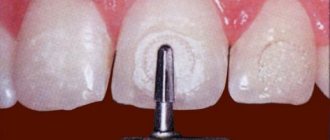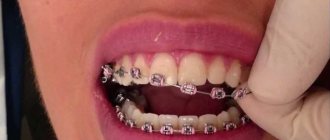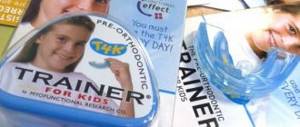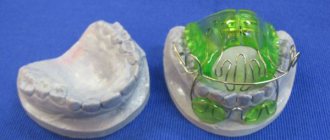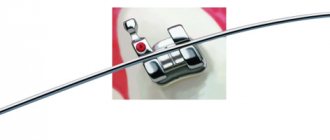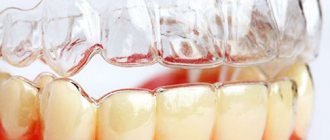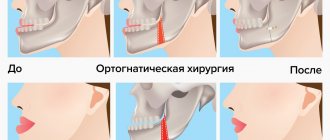Orthodontic treatment gives the best results in childhood. It is easier to correct malocclusion in children, since their jaw and teeth are just developing. However, this does not mean that braces are contraindicated for adults. They can be installed even after 30 years, but the treatment process will be longer. Let's consider its features.
The formation of the dental system ends around 17-18 years, but a child’s permanent bite is formed by 12-13 years. It is best, according to dentists, to install braces at the age of 10-12, when the last molars grow.
In this article
- Should I get braces after 30?
- In what cases should you get braces after 30 years?
- When should you not get braces at 30?
- Braces at 30: features of installation and wearing
- Which braces are best for people over 30?
- How to install braces for adults
- Does it hurt to wear braces?
However, it all depends on individual characteristics. Sometimes doctors suggest waiting a bit for the jaw to form without braces. And in some cases, on the contrary, their immediate installation is required. The need for such treatment is determined primarily by medical indications, and only then by the patient’s wishes.
Should I get braces after 30?
Many people believe that installing braces after 30 years is pointless, dangerous or painful, so they refuse orthodontic treatment. However, it is worth understanding that malocclusion, which can develop in various forms, can cause many complications. Among them:
- Caries, gingivitis and other oral diseases that occur due to poor hygiene and uneven distribution of chewing load.
- Pain in the jaw, which can radiate to the temples and eyebrows, which is a consequence of compression of the nerves and joints.
- Rapid wear of some teeth, abrasion of enamel, loss of teeth.
- Diseases of the gastrointestinal tract due to poor chewing of food.
- Psychological problems associated with self-esteem and complexes that an ugly smile gives rise to.
Let's consider the indications for which braces are placed even after 30 years.
Psychological aspect
Children don't like wearing braces, but they find it easier to adapt to them because many of their peers are also undergoing orthodontic treatment. Adults have more problems: not only psychological, but also everyday ones. If the work involves communicating with people, speaking in public, and requires a representative appearance, the braces system can create serious inconvenience. Other patients are simply embarrassed to wear it: they feel that it only emphasizes the imperfections of their smile.
To cope with psychological discomfort, you can “try on” a sample of an orthodontic design, reminding yourself more often that it only needs to be worn for a few months, and that the result will be straight teeth. If this does not help, you can use alternative treatment methods: using removable aligners, veneers, etc.
Partly due to psychological problems, adaptation to wearing orthodontic structures is more difficult for adults: they feel that braces interfere, rub, injure mucous membranes, change the taste of food, etc. If such problems arise, you need to visit an orthodontist so that he can check the condition of the installed structure. Normally, adaptation takes place in less than a month.
In what cases should you get braces after 30 years?
The reason for installing braces at any age is an incorrect bite, which can manifest itself in different ways. Typical signs of this dental problem:
- crowding of teeth and their creeping onto each other;
- large interdental spaces;
- tooth growth to the sides;
- excessive protrusion of one jaw forward;
- large distance between the upper and lower rows of teeth;
- shifting the jaws sideways in opposite directions.
These anomalies are not always noticeable to the naked eye. In some people they are hidden, but at the same time they cause severe discomfort, for example, while eating. In this regard, many refuse to wear braces, getting used to this discomfort. However, it is recommended to undergo orthodontic treatment even in cases where there are malocclusions, but there is no visible aesthetic defect.
Bite and body position in space
There is a connection between the condition of the dentition and a person’s ability to control his body. In 2021, a team of authors from Spain published a paper suggesting that occlusal abnormalities negatively impact postural control.
Postural control is a person’s ability to control the position of his body in space. It includes concepts such as postural stability and postural orientation. The first is associated with the ability to maintain a vertical position in any situation, the second – with the ability to interact with individual parts of the body in space.
Stability and orientation are determined by the work of the vestibular nuclei of the brain. The functioning of these nuclei is influenced by a large number of factors, including impulses from the trigeminal nerve, of which sensory and motor fibers are part. The branches of the trigeminal nerve go to many anatomical structures on the face, including the masticatory muscles, the rhythmic contractions of which ensure the grinding of food with the teeth.
Improper closure of the dentition, changes in the load during chewing through a feedback mechanism changes the tone of the muscles of the neck and upper back. This, in turn, affects posture, gait, and coordination of movements. Different parts of the musculoskeletal system are connected to each other, so changes that begin in the neck can lead to the development of flat feet and other “remote” disorders.
In everyday life, ordinary people may not notice the existing problem with coordination of movements and movement of the body in space. But in professional sports, all this can have adverse consequences: affect training results and increase the likelihood of injury.
The good news is that the musculoskeletal system is a dynamic system in which individual parts are constantly “adjusting” to changing conditions. This means that correcting the bite improves the ability to have postural control.
When should you not get braces at 30?
There are several more restrictions for installing braces at the age of 30 and later than contraindications for orthodontic treatment in childhood. This is due to the fact that the dental system has already been formed and some defects are difficult or even impossible to correct.
In addition, adults may have crowns or fillings in their mouths that interfere with the placement of orthodontic braces. There are other restrictions. In most cases they are relative:
- serious anatomical changes in the jaws;
- severe wear of crowns;
- the presence of carious cavities and old fillings;
- some diseases of the nervous and cardiovascular systems.
There are few absolute restrictions: HIV, tuberculosis, very weak immunity, etc. Before installing braces in adulthood, longer preparation is required. In general, the process of treating malocclusion in children and adults is practically no different. There are only a few nuances.
Ways to correct a bite
It is easier for a child to correct a bite than for an adult. Teeth are more mobile and easier to straighten. For this, doctors prescribe plates, mouth guards and trainers. The plates are a removable metal structure. It is suitable for children from three years old, does not interfere with everyday life and is made individually for each patient. The mouthguard is a transparent, removable design. It is invisible on the teeth, does not cause discomfort, and is easy to care for. Trainers look like mouth guards, but are more massive and noticeable, usually in bright colors. The most effective for children from 5 to 12 years old, the treatment period is on average less than a year.
To correct the bite in adults, braces, aligners, and surgical operations are used. The most popular are braces. They are suitable for almost every clinical case, effective, relatively affordable and safe to use. Treatment with braces lasts from six months to 2-3 years, depending on the clinical case. As for aligners, this is a modern method of treatment, more expensive than braces. Aligners are transparent, removable aligners that are made according to an individual impression of the patient’s jaw.
The doctor chooses the treatment option depending on the patient’s wishes, the degree of malocclusion and other characteristics of the body.
Braces at 30: features of installation and wearing
Getting braces at age 30 is not dangerous or painful, but orthodontic treatment in adulthood is not without difficulties. Often people encounter the following problems:
- Long preparation and treatment. Before installing orthodontic structures, all dental diseases must be cured. In adults there may be more of them than in children, so the preparatory stage of treatment can last for several weeks. Many people are interested in how long they need to wear braces if they are installed after 30 years. As practice shows, even minor defects require at least a year to eliminate; sometimes you have to wear braces for 2-3 years.
- It may be necessary to remove some teeth, often figure eights, to create space for the remaining teeth once they are straightened.
- In some cases, it is necessary, on the contrary, to install or replace additional structures, for example, crowns on which the braces will rest.
- It will take a long time to consolidate the result with the help of special means and instruments, otherwise the teeth may return to their original position. This often happens with significant defects.
In other words, an adult who wants to correct an overbite will have to be patient. The treatment will be long, but, according to people who have undergone it, it will be effective and justified.
Is surgical correction dangerous?
Jaw surgery is a serious process that must be carefully planned. It is carried out only after a detailed diagnosis and drawing up a treatment plan. The capabilities of modern diagnostics make it possible to predict the outcome of treatment with high accuracy, and with the help of computer modeling of orthodontic and surgical procedures, the doctor can clearly demonstrate to the Patient his future smile.
Of course, with any surgical intervention on the body there are certain risks. It is necessary to understand that a competent specialist will be able to reduce them to a minimum and prevent all possible negative consequences.
Thus, the degree of complexity of treatment depends not on the curvature of the teeth, but on the disproportion in the size of the jaws. But modern orthodontics makes it possible to correct even the most serious skeletal problems with bite not only by moving teeth, but also by using the surgical method.
Which braces are best for people over 30?
There are many varieties of brace systems, which differ from each other in a number of indicators: material of manufacture, strength, aesthetic properties, reliability of fixation, etc. As a rule, the orthodontist offers the patient several types of structures to choose from. When choosing braces, consider the following factors:
- Profession. A person who has to speak in public or often communicate with people can choose plastic, ceramic or sapphire braces: they are almost invisible to others. Lingual systems that are installed on the inner surface of the dentition are also well suited.
- The degree of bite pathology. Severe forms are better corrected with metal staples. In addition, they provide faster correction compared to plastic and ceramic structures.
- Price. The most expensive braces are made from sapphire, and ceramic products are also expensive. If you want to save money, but not at the expense of treatment, choose metal or plastic staples.
- Physical limitations. Lingual braces are more difficult to maintain. For people with disabilities, if they cannot fully care for their oral cavity, it is better to opt for vestibular structures.
But the main factor that determines the choice of braces is medical indications.
How to install braces for adults
Regardless of which system will be installed for the patient, he first undergoes an examination, during which indications and contraindications are determined. The main research method is radiography, which allows you to take pictures of the jaws and make impressions based on them. Next, the oral cavity is sanitized: treatment of dental diseases and ultrasonic cleaning. If necessary, extra teeth – molars or “eights” – are removed.
After preparation, the bracket system is installed. This is done according to the following algorithm:
- teeth are cleaned of plaque, saliva is removed, and the oral cavity is dried;
- the enamel is treated with a special solution, which makes it more susceptible to glue;
- An adhesive composition is applied to the surface of the tooth crown, and cement is applied to the bracket lock;
- the clasps are fixed on the teeth, after which they are dried with an ultraviolet lamp;
- excess glue is removed with a solvent;
- An arch is threaded into the braces, which corrects the bite by applying pressure to the jaw.
Installation can be direct or indirect. In the first case, each clasp is glued to one tooth; in the second, the dentist creates a structure on a mock-up of the jaw, and then transfers it to the patient’s oral cavity.
The arc has a memory effect and gradually begins to return to the shape that was given to it during the modeling of the structure. Due to this, tooth displacement occurs. Periodically, the arch is tightened to increase pressure on the dentition. This continues for 1-3 years, it all depends on the success of the treatment.
Does it hurt to wear braces?
Before installing orthodontic structures, people often wonder if it hurts to put on and wear braces. Painful sensations during the procedure occur only with increased sensitivity of the gums and teeth. To relieve the patient of discomfort, the doctor may give an anesthetic injection.
Pain during wearing braces usually only bothers you during the adaptation period, that is, in the first 5-15 days. If you do not eat hard foods, the pain will be mild. Pain medications are rarely needed.
For treatment to proceed without complications, the patient needs to change his diet and carefully monitor hygiene. You will have to limit yourself in the use of certain products and purchase special products for cleaning the oral cavity: a toothbrush with V-shaped bristles (CURAPROX Ortho), a brush (Biorepair Scovolini Interdentali Cilindrici), dental floss (Mirafloss implant chx), rinses (Biorepair Mouthwash) and irrigator (Little Doctor International Ltd Aquajet LD-A7, Donfeel Donfeel OR-820D Compact). You will need to see your doctor every few months to have the archwire tightened.
In general, it is safe to get braces after 30 years of age. However, they often have no alternative, so they will have to choose: either not try to solve the problems caused by malocclusion, or be patient a little and get a healthy and beautiful smile.
Is it possible to correct an overbite as an adult?
The optimal period for orthodontic treatment begins at 12 and ends at 25 years. The younger the patient, the faster and easier it is to get the desired result. But you can install braces at an older age. Some patients decide to undergo such treatment even at 40-50 years of age. However, at this age, the period of correction increases significantly, and after achieving the result, you have to wear retainers for a long time, sometimes for the rest of your life.
In any case, if you have malocclusion, you should try to correct it at any age. To do this, first of all, you need to visit an orthodontist, undergo diagnostics and get advice from a specialist about the possible effectiveness of orthodontic treatment.

